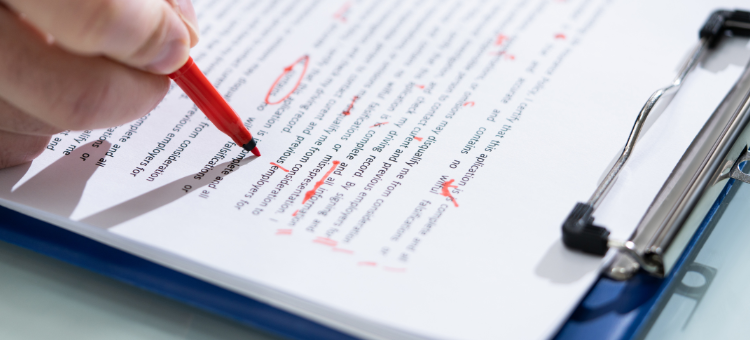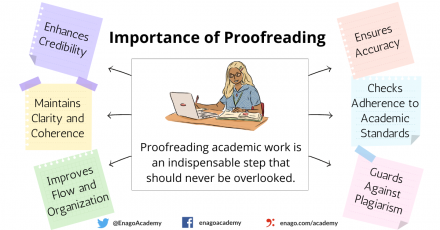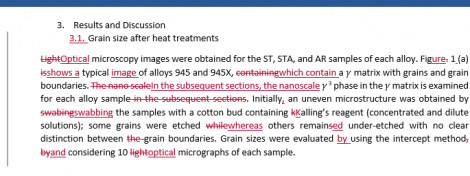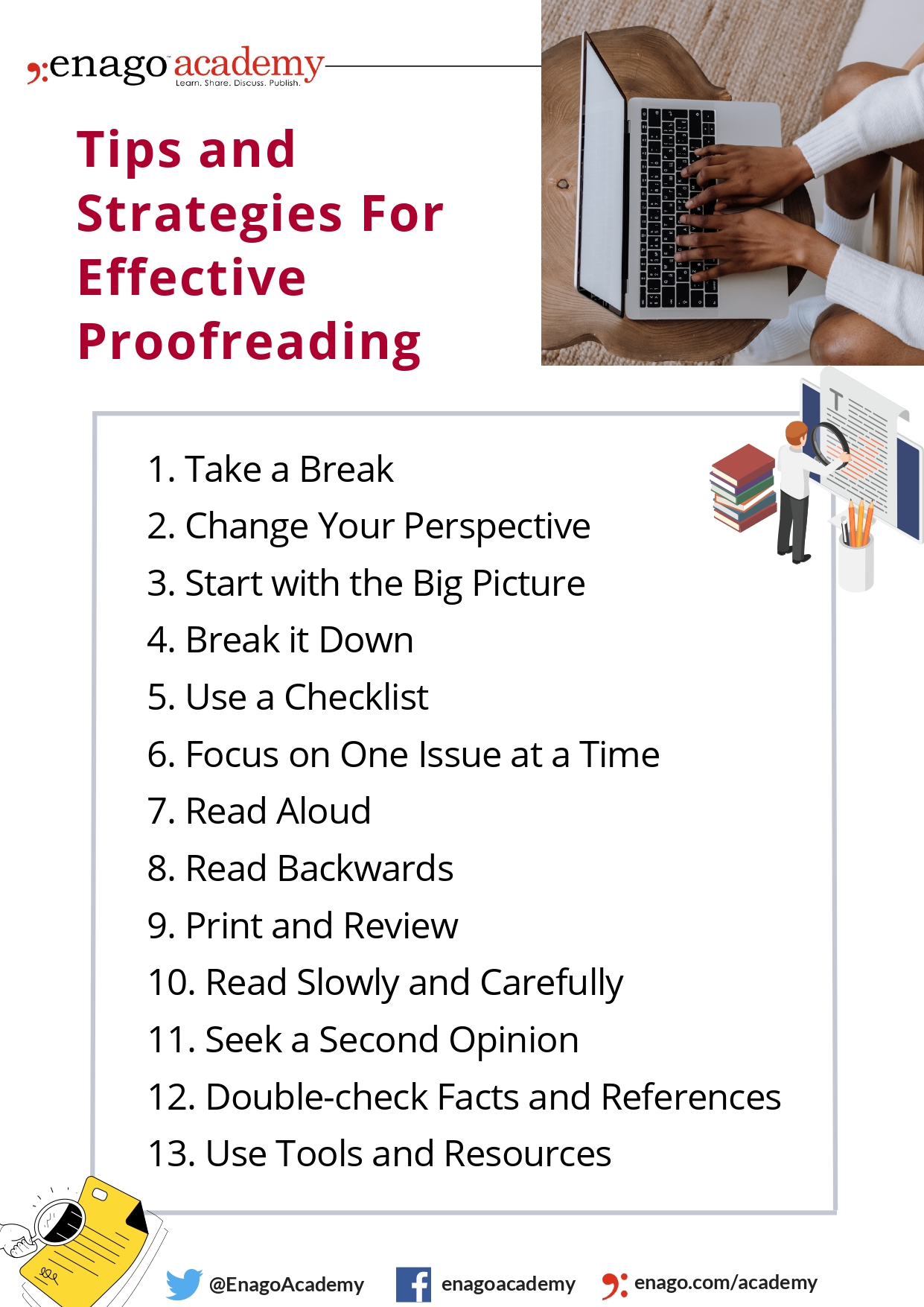The Power of Proofreading: Taking your academic work to the next level

Preparing your scientific work for submission can be a nerve-wracking experience. Be it the high expectations of reviewers, the stringent guidelines of target journals, or your professor’s watchful eyes, that one glaring error overshadowing your hard work and brilliant ideas can send shivers down your spine. But fear not, for there is a weapon that can shield us from the embarrassment of those avoidable slip-ups: proofreading.
Imagine the impact of submitting an assignment that is not only filled with insightful content but is also devoid of those troublesome spelling mistakes, grammatical blunders, and formatting mishaps.
What Is Proofreading?
Proofreading is the process of carefully reviewing a written document for errors, inconsistencies, and improvements prior to its finalization or publication. This critical process involves scrutinizing the text for spelling, grammar, punctuation, formatting, typographical errors, and the overall presentation of the content, all in pursuit of ensuring utmost accuracy and clarity.
The essence of proofreading lies in enhancing the quality of your paper, leaving no room for lingering errors or inconsistencies in writing. It is about achieving a well-defined communication goal, where the content is effectively conveyed, and every sentence is grammatically and syntactically correct. By proofreading, you can transform your manuscript into a masterpiece, ready to be submitted to prestigious scientific journals.
The Different Types of Proofreading
There are different types of proofreading that can be performed depending on the specific needs and requirements of the written document. Here are some common types of proofreading:
- Academic Proofreading: Academic proofreading focuses on reviewing academic papers, dissertations, theses, or research articles. It includes checking for proper citation formatting, adherence to referencing styles (such as APA or MLA), ensuring accuracy in referencing and bibliographies, proper spelling conventions (i.e., either British English or American English), checking for formatting requirements for tables and figures and verifying the consistency of terminology and language. Academic proofreading services are in high demand because researchers and scholars often need assistance in ensuring the quality and language accuracy of their work. These services are committed to delivering high-quality language editing and proofreading solutions. Expert proofreaders who possess advanced subject-matter expertise can assist you in polishing your academic and scientific manuscripts to ensure clarity, accuracy, and effective communication.
- Translation Proofreading: Bilingual proofreading or translation proofreading is a specialized discipline that revolves around the meticulous review and assurance of accuracy and quality in translated texts. This unique form of proofreading entails scrutinizing the translated content alongside the original source text to ensure the accurate representation of the intended meaning and message. A proficient bilingual proofreader must possess a profound understanding of both languages involved and possess knowledge of common translation challenges and potential pitfalls in phrasing. Their expertise lies in identifying and rectifying errors such as incorrect application of grammatical conventions from the source language to the target language. For instance, in Korean, it is customary to enclose titles or headlines within brackets [], whereas in English, titles are typically presented in bold or underlined format. Online translation proofreading services serve as invaluable resources for individuals or organizations seeking the expertise of experienced bilingual proofreaders to review their translated works.
- Print Media Proofreading: It is a well-established type of proofreading that plays a crucial role in guaranteeing flawless and visually captivating publications. Be it newspapers, magazines, journals or book publishing companies, print media proofreaders contribute to the production of error-free and visually appealing publications that meet the highest standards of quality and professionalism. Attention to formatting details such as margins, text size, spacing, and font selection are imperative because print media must maintain a flawless appearance both in print and online.
Why Is Proofreading Important?
Words hold immense power, but their impact can be lost amidst a fog of confusion. That’s where proofreading swoops in! It identifies convoluted sentences, tangled ideas, and misused words, helping you streamline your message. Through this process, proofreading molds your writing into a smooth symphony of coherence, ensuring that your readers grasp your ideas with crystal-clear understanding. Proofreading academic work is an indispensable step that should never be overlooked. Here are some key reasons why proofreading is crucial:

- Enhancing Credibility: Academic work serves as a representation of your knowledge, skills, and expertise. Errors and mistakes can undermine your credibility as a researcher or student. Proofreading ensures that your work is polished and error-free, allowing your ideas to shine and establishing your authority in the field.
- Maintaining Clarity and Coherence: Academic writing often deals with complex concepts and ideas. Proofreading enables you to detect and correct any instances of confusing or ambiguous language, awkward sentence structures, or logical inconsistencies within your academic work. By enhancing the clarity and coherence of your writing, proofreading ensures that your readers can comprehend and engage with your arguments effectively.
- Improved Flow and Organization: By reviewing the logical progression of ideas, checking the coherence of paragraphs, and ensuring smooth transitions between sections, you can create a more cohesive and well-structured piece of work. This leads to a more engaging reading experience and helps readers navigate your content more effectively.
- Ensuring Accuracy: Accuracy is essential in academic writing, especially when presenting data, conducting experiments, or analyzing research findings. Proofreading aids in the identification and correction of factual inaccuracies, numerical errors, and misinterpretations before finalizing and submitting your work. This attention to detail strengthens the reliability and validity of your research.
- Adhering to Academic Standards: Academic institutions and journals often have specific formatting guidelines, citation styles, and language conventions that must be followed. Proofreading is a vital step in ensuring that your work aligns with these academic standards, encompassing crucial aspects such as proper citation formatting, consistent referencing, and adherence to academic style guides. By conforming to these guidelines, you demonstrate professionalism and respect for scholarly conventions. It prevents inconsistencies that may confuse readers or raise doubts about the reliability of your research.
- Guarding Against Plagiarism: Plagiarism is a serious ethical violation in academia. Through proofreading, you can meticulously review your sources, citations, and references to ensure that you have properly acknowledged and attributed the ideas, concepts, and theories of others. This practice promotes academic integrity and intellectual honesty, avoiding unintentional plagiarism and upholding the principles of scholarly integrity.
The example below demonstrates the importance of proofreading your manuscript, where attention to detail and effective communication are crucial.
 Source: Enago (English Proofreading Services)
Source: Enago (English Proofreading Services)
Choosing the Perfect Proofreading Service: Key factors to consider
When it comes to choosing the best proofreading service, there are several important factors to consider. Here are some key things to keep in mind:
- Expertise and Specialization: Look for a proofreading service that has expertise in your specific field or type of writing. Different subjects and industries may have unique terminology, conventions, and standards. Opting for a service with experience in your area ensures that the proofreaders understand the nuances of your work and can provide accurate feedback.
- Reputation and Reviews: Research the reputation of the proofreading service before making a decision. Read reviews and testimonials from previous clients to get a sense of their satisfaction level. A reputable service will have positive feedback, indicating their reliability, professionalism, and commitment to delivering high-quality results.
- Turnaround Time: Consider your timeline and deadlines. Ensure that the proofreading service can accommodate your schedule and provide a turnaround time that meets your needs. While efficiency is important, make sure they don’t compromise the quality of their work by rushing through the process. A balance between speed and thoroughness is crucial.
- Pricing and Transparency: Compare the pricing structures of different proofreading services. While cost shouldn’t be the sole determining factor, it’s important to understand the pricing and ensure it aligns with your budget. Look for transparency in their pricing model and clarity regarding what services are included in the package. Be wary of hidden fees or charges.
- Additional Services and Support: Consider whether the proofreading service offers any additional services or support that could benefit your writing. Some services may provide constructive feedback, suggestions for improvement, or even formatting assistance. Assess what additional value they bring beyond basic proofreading.
By considering these factors, you can make an informed decision when choosing a proofreading service that best suits your needs. Remember, finding the right service can greatly enhance the quality and impact of your writing, ensuring that your work is polished, professional, and error-free.
Tips and Strategies For Effective Proofreading

1. Take a Break: Before you begin proofreading, grant yourself a well-deserved break from your writing. This interval serves the purpose of clearing your mind, enabling you to approach the text anew with a refreshed perspective and rejuvenated eyes. Ideally, step away for a few hours or even a day, if possible.
2. Change Your Perspective: Try to view your work from a different perspective. Read it as if you were a reader encountering it for the first time. This shift in perspective can help you identify errors or areas that need improvement more effectively.
3. Start with the Big Picture: Begin by focusing on the overall structure, flow, and coherence of your writing. Check if your ideas are presented logically and if the content is organized in a clear and concise manner. Make sure your paragraphs and sentences flow smoothly from one to another.
4. Break it Down: Instead of trying to proofread the entire document at once, break it down into smaller sections. This approach allows you to concentrate on each section more effectively and reduces the chances of overlooking errors.
5. Use a Checklist: Create a proofreading checklist to guide your review process. Include items such as spelling, grammar, punctuation, formatting, consistency, and clarity. Utilizing a checklist is a valuable practice that helps minimize the risk of overlooking errors. It provides a systematic approach to reviewing your work, ensuring that all essential aspects are covered.
6. Focus on One Issue at a Time: Instead of trying to catch all types of errors at once, focus on one aspect of proofreading at a time. For example, dedicate a pass to checking for spelling mistakes, another for grammar and punctuation, and another for clarity and coherence. This focused approach helps you maintain attention to detail and reduces the chances of overlooking errors.
7. Read Aloud: By reading your work aloud, you can pinpoint awkward phrasing, identify run-on sentences, and uncover other issues that may not be immediately noticeable when reading silently. This approach allows you to catch grammatical errors and identify areas where the flow of your writing could be enhanced, as hearing the words spoken aloud offers a fresh perspective on the overall quality and effectiveness of your writing.
8. Read Backwards: When proofreading for spelling and typos, try reading your work backwards, sentence by sentence or paragraph by paragraph. This technique helps you focus solely on individual words rather than getting caught up in the flow of the text. It can be particularly useful for catching spelling errors that may have been overlooked when reading normally.
9. Print and Review: If possible, print a hard copy of your work for proofreading. Reading a physical copy can sometimes help you spot errors that were missed on the screen. Use a pen or highlighter to mark any corrections or changes you need to make.
10. Read Slowly and Carefully: It is imperative to invest ample time and read each word and sentence with meticulous care. Pay attention to the details and ensure that each sentence makes sense and flows smoothly. By refraining from rushing through the proofreading process, you can guarantee a comprehensive and accurate review, resulting in a refined and polished piece of work.
11. Seek a Second Opinion: Consider asking a peer, colleague, or friend to review your work. Fresh eyes can often catch errors or suggest improvements that you might have missed. Another person’s perspective can provide valuable insights into areas where your writing can be strengthened.
12. Double-check Facts and References: If your work includes facts, statistics, or references, make sure to double-check their accuracy. Verify the sources, dates, and supporting evidence to ensure that your information is reliable and up-to-date.
13. Use Tools and Resources: Make effective use of grammar and spell-checking tools, such as dedicated grammar checkers or reliable proofreading software. However, be cautious as these tools are not infallible and may not catch all mistakes. They should be used as aids rather than relied upon solely. While it may be tempting to depend on friends or colleagues for proofreading, it is crucial to recognize that their text writing proficiency may have certain constraints. It’s highly advised to seek professional help for proofreading if required.
Remember, proofreading is a meticulous process that requires time, patience, and a keen eye for detail. By implementing these strategies, you can enhance the effectiveness of your proofreading efforts and ensure that your writing is devoid of errors, cohesive, and impeccably polished.
In Conclusion
In the world of academia, where knowledge is created and shared, the importance of proofreading is often underestimated. Your academic work is a reflection of your intellect, research, and dedication, and it deserves to shine in all its glory. Thus, proofreading is a critical step in the writing process that allows you to fine-tune your work and maximize its impact. By investing time and effort in proofreading, you can elevate the quality of your work, effectively communicate your ideas, and make a lasting impact in your academic pursuits. Now, it’s time to put these strategies into action. So, grab your magnifying glass get ready to captivate your readers, impress your professors, and leave an indelible mark with your flawlessly polished prose. It’s time to embrace the magic of proofreading and elevate your words from mere sentences to masterpieces. Feel free to reach out to Enago Academy using #AskEnago and tag @EnagoAcademy on Twitter, Facebook, and Quora for expert tips, insights, and resources on academic writing and publishing.










Intelligent 🤌